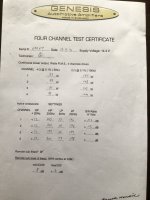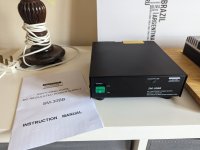I agree with perceval. It’s not that the FR can do it, it‘s whether it should. Limiting the bass will lower distortion and clean up the midrange. Leave the bass to the bass drivers.
Sorry, I’ve been at work so have only just had a chance to answer.Thing is... even though your FR drops at about 200Hz, it doesn't mean that it isn't trying to reproduce lower frequencies.
By adding at the minimum, a cap, you will help it free itself from trying to reproduce the lower frequencies, and it will in turn clean up the performance greatly higher up.
This the one element of speaker that has me slightly baffled(😉) so I’ll ask for your advice on this if I may.
If I were to high pass the FR drivers using a passive filter/cap, how would I do this?
Should I choose crossover point at 200hz or a little below?
Bearing in mind the -6db per octave roll-off of OB below the frequencies supported by the baffle, what slope would I go for?
I would want the filter to have as little effect as possible on the efficiency or phase etc. of the driver.
Assuming a simple ’cap’ is best (which it might not be) then what value and type of caps would I order?
I would place them just before the speaker input terminals for the FR driver so that I can switch them in/out without touching the existing speaker wiring.
The other option that occurred to me is to trial the Genesis amplifier with the front channels High passed actively in stereo for the FR drivers and the rear channels low passed actively for the SB20s. I would just need to amplify the Bianco separately. An advantage of this approach would be that the Genesis only needs one set of RCA inputs and one power supply for 4 channels. Obviously I’d just need a pre-amp signal going to the Genesis.
I have attached a copy of the test certificate for this amplifier which was serviced (by the man who designed it) back when I bought it in 2014. Rightly or wrongly I’m assuming this amplifier will output up to circa 50wpc into 8 ohms looking at specs. The SB20s are 8 ohm versions wired in parallel into 4 ohms.
Attachments
I won't be home for a few days, so I'll be brief.
If you measure your woofers, and see the cut off your amp gives you, use a nice tool like XSim to mesh in the FR. It will give you a graphical representation of what you are trying to achieve.
If you measure your woofers, and see the cut off your amp gives you, use a nice tool like XSim to mesh in the FR. It will give you a graphical representation of what you are trying to achieve.
I'm waiting for my pair of SB20FRPC30 to arrive....
Do you think it might work well in Troels' TQWT ? http://www.troelsgravesen.dk/DTQWT-mkIII/TQWT-mkIII.png
I'm thinking of using it as substitute for the JA8008HMQ
Do you think it might work well in Troels' TQWT ? http://www.troelsgravesen.dk/DTQWT-mkIII/TQWT-mkIII.png
I'm thinking of using it as substitute for the JA8008HMQ
I'm not at that level unfortunately...
If anyone wants to give it a try perhaps, I'd be very grateful
If anyone wants to give it a try perhaps, I'd be very grateful
Here is quick approximation in Hornresp (file attached), no filling. Filling smoothes out peaks and dips, more effectively at higher frequencies, and reduces efficiency a bit. this doesnt account for the fold, but it shouldnt have a major effect at the low end:

Here is similar volume BR for reference, tuned to 32Hz:

Here is similar volume BR for reference, tuned to 32Hz:
Attachments
Last edited:
Well, that's pretty bad.
I'd say forget that Troels in this instance, and go for a MLTL, that simulates quite nicely.
I'd say forget that Troels in this instance, and go for a MLTL, that simulates quite nicely.
@perceval , could you please point me to the where I can find more information about the MLTL please?go for a MLTL
Is that the most successful implementation so far, in your opinion?
one will have bass, the other won't and will need woofers/subs.
The 12v power supply arrived from Radioworld yesterday afternoon so, as soon as I get a chance to make a stand incorporating all the cabling four the Genesis amplifier I will test the FR drivers using an active HP cut off.
I did ring the shop I bought the SBs from and he said that he would be cautious applying much of a passive filter to an FR driver. In his opinion the beauty of an FR driver and the SB in particular (which he compared favourably to some £500 FR drivers) was the purity and efficiency gained from not needing a crossover.
He did suggest that a small baffle step circuit might be helpful if I deemed I needed it but something that can easily removed if the negatives outweigh the pluses.
As I say I will see how it all works with experimenting with an active HP filter and go from there. I might also have a go at calculating baffle step values too.
I did ring the shop I bought the SBs from and he said that he would be cautious applying much of a passive filter to an FR driver. In his opinion the beauty of an FR driver and the SB in particular (which he compared favourably to some £500 FR drivers) was the purity and efficiency gained from not needing a crossover.
He did suggest that a small baffle step circuit might be helpful if I deemed I needed it but something that can easily removed if the negatives outweigh the pluses.
As I say I will see how it all works with experimenting with an active HP filter and go from there. I might also have a go at calculating baffle step values too.
Attachments
First that guy says that you should keep the "purity" of the driver by not adding any passive circuit, then he suggests adding a BSC passive circuit. Yep, makes sense.
I remember a discussion where a member here said he coud hear a solder joint and was all about the "purity" of the signal. This is audio... and so many have dogmatic ideas about audio.
I remember a discussion where a member here said he coud hear a solder joint and was all about the "purity" of the signal. This is audio... and so many have dogmatic ideas about audio.
Received mine last week. Very nice looking 🙂
Annoyingly they're just a few mm wider than my current cheapo 8" so I can't do a drop in replacement to test them.
More bad wood work is called for 😀
Has anyone had any issues with the plastic chassis and surround? I worried about cracking it with too much pressure from mounting screws?
Annoyingly they're just a few mm wider than my current cheapo 8" so I can't do a drop in replacement to test them.
More bad wood work is called for 😀
Has anyone had any issues with the plastic chassis and surround? I worried about cracking it with too much pressure from mounting screws?
I am careful not to overtighten the plastic basket as it will distort.
I use 3mm wood screws.

I use 3mm wood screws.
No issues per se, but yes: don't over-tighten or you can run the risk of cracking the basket, or more likely, warping it out of alignment. Polymer baskets have some advantages over regular alloy / steel unless you really go to town with fairly 'involved' methods of mounting them to the baffle -they usually have better self-damping for a start- but you do need to go a bit easier when fixing.
Anyone that can ‘hear’ solder definitely has super powers.First that guy says that you should keep the "purity" of the driver by not adding any passive circuit, then he suggests adding a BSC passive circuit. Yep, makes sense.
I remember a discussion where a member here said he coud hear a solder joint and was all about the "purity" of the signal. This is audio... and so many have dogmatic ideas about audio.
- Home
- Loudspeakers
- Full Range
- SB Acoustics SB20FRPC30-8 (8" Fullrange Cheap Monster II)

